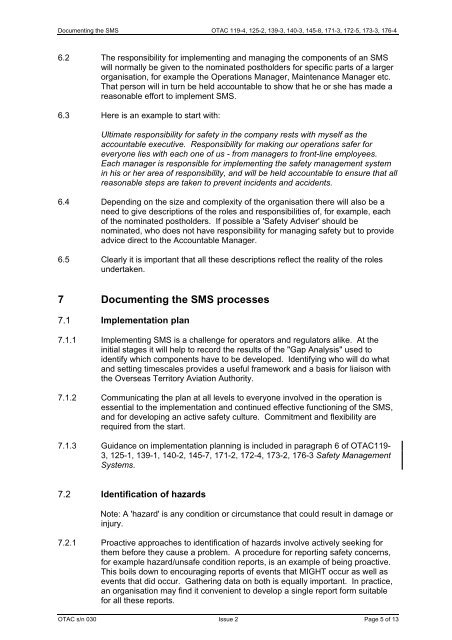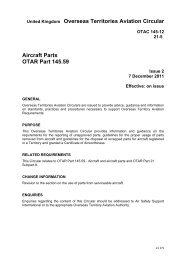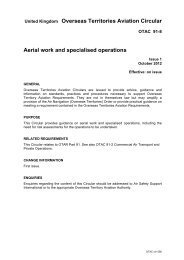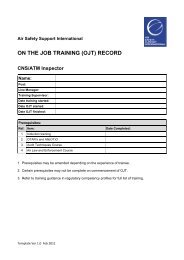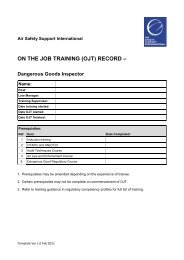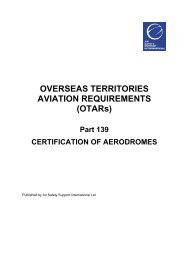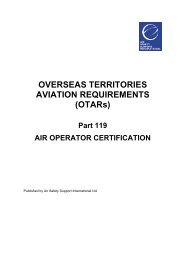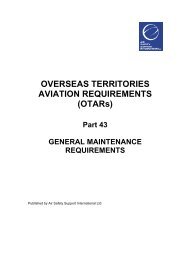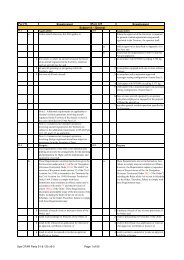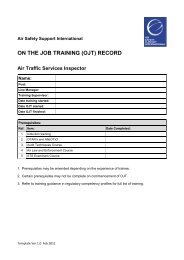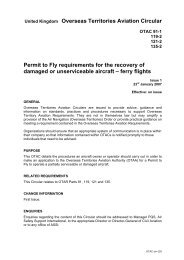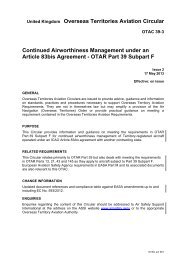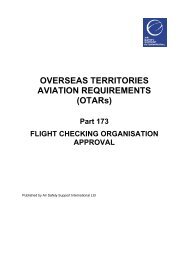UK Overseas Territories Aviation Circular (OTAC) - Air Safety ...
UK Overseas Territories Aviation Circular (OTAC) - Air Safety ...
UK Overseas Territories Aviation Circular (OTAC) - Air Safety ...
Create successful ePaper yourself
Turn your PDF publications into a flip-book with our unique Google optimized e-Paper software.
Documenting the SMS <strong>OTAC</strong> 119-4, 125-2, 139-3, 140-3, 145-8, 171-3, 172-5, 173-3, 176-46.2 The responsibility for implementing and managing the components of an SMSwill normally be given to the nominated postholders for specific parts of a largerorganisation, for example the Operations Manager, Maintenance Manager etc.That person will in turn be held accountable to show that he or she has made areasonable effort to implement SMS.6.3 Here is an example to start with:Ultimate responsibility for safety in the company rests with myself as theaccountable executive. Responsibility for making our operations safer foreveryone lies with each one of us - from managers to front-line employees.Each manager is responsible for implementing the safety management systemin his or her area of responsibility, and will be held accountable to ensure that allreasonable steps are taken to prevent incidents and accidents.6.4 Depending on the size and complexity of the organisation there will also be aneed to give descriptions of the roles and responsibilities of, for example, eachof the nominated postholders. If possible a '<strong>Safety</strong> Adviser' should benominated, who does not have responsibility for managing safety but to provideadvice direct to the Accountable Manager.6.5 Clearly it is important that all these descriptions reflect the reality of the rolesundertaken.7 Documenting the SMS processes7.1 Implementation plan7.1.1 Implementing SMS is a challenge for operators and regulators alike. At theinitial stages it will help to record the results of the "Gap Analysis" used toidentify which components have to be developed. Identifying who will do whatand setting timescales provides a useful framework and a basis for liaison withthe <strong>Overseas</strong> Territory <strong>Aviation</strong> Authority.7.1.2 Communicating the plan at all levels to everyone involved in the operation isessential to the implementation and continued effective functioning of the SMS,and for developing an active safety culture. Commitment and flexibility arerequired from the start.7.1.3 Guidance on implementation planning is included in paragraph 6 of <strong>OTAC</strong>119-3, 125-1, 139-1, 140-2, 145-7, 171-2, 172-4, 173-2, 176-3 <strong>Safety</strong> ManagementSystems.7.2 Identification of hazardsNote: A 'hazard' is any condition or circumstance that could result in damage orinjury.7.2.1 Proactive approaches to identification of hazards involve actively seeking forthem before they cause a problem. A procedure for reporting safety concerns,for example hazard/unsafe condition reports, is an example of being proactive.This boils down to encouraging reports of events that MIGHT occur as well asevents that did occur. Gathering data on both is equally important. In practice,an organisation may find it convenient to develop a single report form suitablefor all these reports.<strong>OTAC</strong> s/n 030 Issue 2 Page 5 of 13


